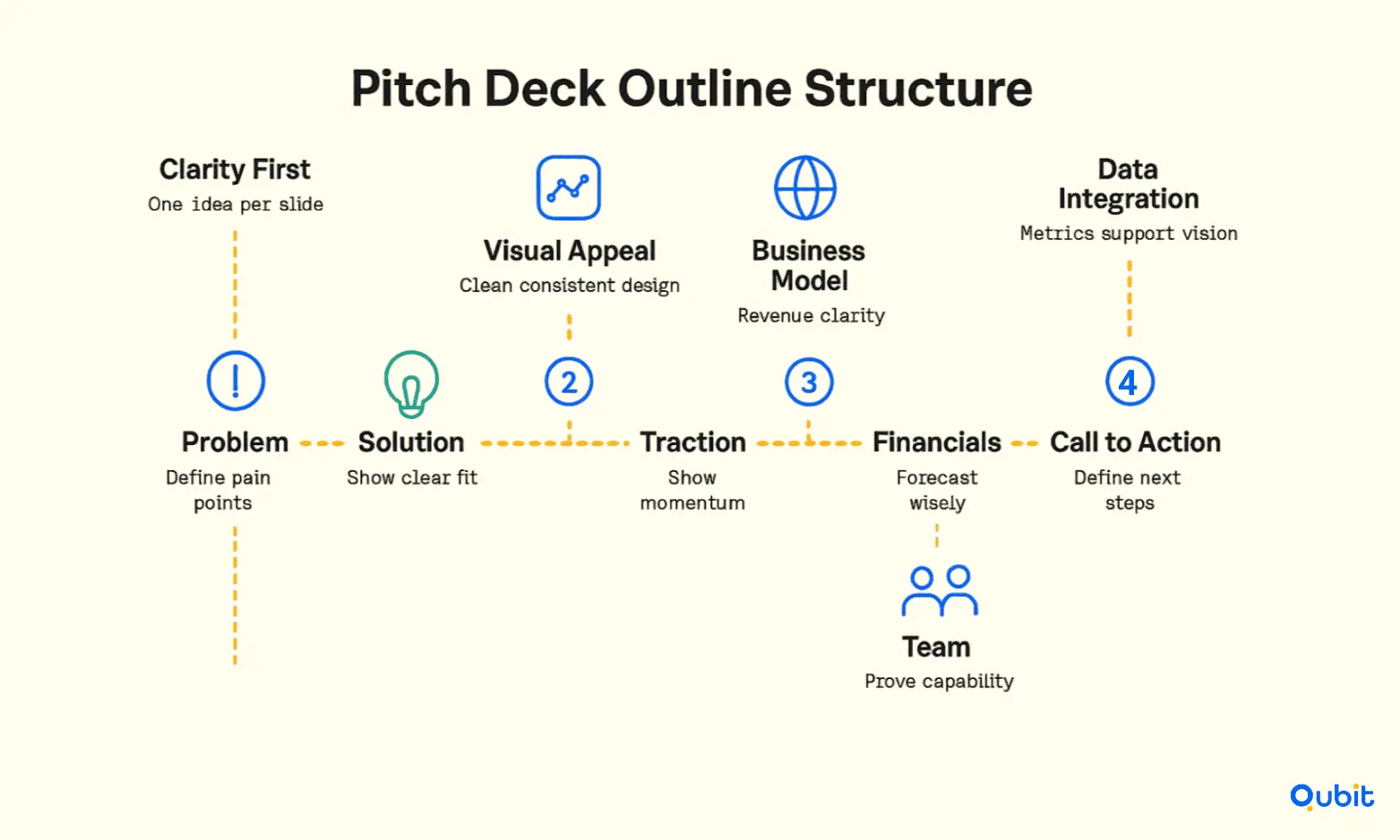A pitch deck serves as the cornerstone of investor outreach in the venture capital ecosystem. For software startups, it’s not just about presenting ideas, it’s about crafting a compelling narrative that resonates with potential investors. Pitch decks are the most common format used by startups in the venture capital ecosystem to solicit investment, underscoring their universality in attracting funding.
This blog will guide software founders through the essential steps to create a pitch deck that stands out. From understanding emerging trends like asymmetrical visual layouts to incorporating AI-powered insights, we’ll cover everything you need to know.
Defining the Importance of a Pitch Deck
Startups often face the challenge of presenting complex ideas in a way that resonates with investors. A pitch deck simplifies this process by structuring the narrative into digestible slides, highlighting key aspects such as market opportunity, product value, and financial projections. Its visual nature ensures that the audience remains engaged while absorbing critical information.
Beyond its role in storytelling, a pitch deck is instrumental in establishing credibility. It demonstrates the startup’s preparedness and clarity of purpose, which are essential for building investor confidence. Moreover, the deck acts as a roadmap, guiding discussions and ensuring that the presentation stays focused on the most impactful points.
For software startups, the arrangement and sequencing of essential content are particularly crucial. Insights from software pitch deck slides reveal how a well-structured flow can enhance the narrative, making it easier for investors to grasp the startup’s potential.
Crafting a Compelling Narrative for Your Pitch Deck
A pitch deck is more than a collection of slides; it’s an opportunity to tell a story that resonates with investors. The purpose extends beyond sharing facts, it’s about creating a strategic narrative that builds trust and inspires action. By weaving together data-driven insights and a clear storyline, you can transform your pitch into a powerful tool for engagement.
The Role of Trust in Investor Decisions
Investors don’t just fund ideas; they invest in the people and vision behind them. A well-crafted narrative establishes credibility by demonstrating a deep understanding of your market, customers, and growth potential. This is where data becomes indispensable. Metrics and insights not only validate your claims but also create a foundation of trust. For example, your analysis of incorporating data-driven metrics is complemented by the discussion in product market fit software investors, which details how user metrics support claims of market adoption.
Structuring a Narrative That Inspires Action
A compelling pitch deck follows a logical flow that mirrors the investor’s thought process. Start by defining the problem your product solves, then present your solution with clarity. Use data to back up your claims, whether it’s market size, user adoption rates, or revenue projections. Each slide should build on the previous one, creating a cohesive story that leads to a clear call to action.
When data is integrated seamlessly into your narrative, it becomes more than numbers, it becomes proof of your vision’s viability. This combination of storytelling and evidence is what keeps investors engaged and confident in your ability to execute.
Tired decks don’t raise rounds, clear ones do. Follow the steps in this pitch deck creation playbook to map problem → solution → proof, and cut the fluff.
Winning Examples and Customizable Pitch Deck Templates
While templates can vary significantly, the most effective pitch decks share key elements: a compelling narrative, clear visuals, and data-driven insights. This section explores standout examples and provides actionable tools to help founders create their own winning decks.
Proven Pitch Deck Examples
Some of the most successful startups have demonstrated how a well-designed pitch deck can secure funding and build investor trust.
Airbnb’s Seed Funding Deck
Airbnb’s early pitch deck is a masterclass in clarity and vision. By emphasizing the peer-to-peer lodging concept, it established trust with investors and raised $600k in seed funding. This example highlights the importance of presenting a clear problem and solution, paired with a scalable business model.Buffer’s Transparent Deck
Buffer took a unique approach by showcasing radical transparency in its metrics and business model. This strategy attracted 18 investors and secured $500k in funding. The deck’s openness about financials and growth projections demonstrated confidence and accountability, which resonated with diverse investor groups.Lyonshare’s Pitch Decks
Lyonshare’s pitch decks have collectively raised over $3B from top-tier investors, including Lightspeed Venture Partners and Union Square Ventures. Their success lies in blending compelling storytelling with actionable data, making them a go-to resource for founders seeking inspiration.
Essential Elements of Effective Pitch Decks
While each pitch deck is unique, certain elements consistently drive investor engagement:
- Clear Problem Statement: Investors need to understand the issue your product or service solves.
- Scalable Solution: Highlight how your solution can grow and adapt to market demands.
- Market Opportunity: Use data to demonstrate the size and potential of your target market.
- Financial Projections: Include metrics such as revenue forecasts, customer acquisition costs (CAC), and lifetime value (LTV). For a detailed breakdown, refer to the saas kpi pitch deck.
Structuring a Powerful Pitch Deck Outline
Below, we break down the essential components of a winning pitch deck outline, blending narrative flow with key data points for maximum impact.

1. Problem Statement
Start by defining the problem your business aims to solve. This slide should clearly articulate the pain points faced by your target audience. Use concise language and, if possible, include statistics or real-world examples to emphasize the urgency of the issue. A well-defined problem sets the stage for the solution you’re about to present.
2. Solution
Follow up with a slide that introduces your solution. Highlight how your product or service addresses the problem effectively and uniquely. Visual aids, such as diagrams or mockups, can help illustrate your solution’s functionality and benefits. Keep the focus on simplicity and clarity.
3. Market Opportunity
Investors want to know the size and scope of your market. Use this slide to showcase the potential for growth, backed by data on market size, trends, and demand. Be specific—mention your target audience and any niche opportunities that differentiate your business from competitors.
4. Business Model
Explain how your business generates revenue. Whether it’s subscription-based, transactional, or advertising-driven, this slide should outline your pricing strategy and revenue streams. Clarity here builds confidence in your financial sustainability.
5. Traction
If your business has already achieved milestones, this is the place to highlight them. Include metrics like user growth, sales figures, or partnerships to demonstrate progress. Traction validates your business model and shows investors that your idea is gaining momentum.
6. Financials
Provide a snapshot of your financial projections. Include key metrics such as revenue forecasts, profit margins, and funding requirements. Keep the data concise and visually appealing—charts and graphs work well here. This slide should reassure investors of your financial acumen and growth potential.
7. Team
Introduce the people behind your business. Highlight their expertise, relevant experience, and roles within the company. A strong team slide builds trust and shows investors that your business is backed by capable individuals.
8. Call to Action
Conclude your pitch deck with a clear call to action. Whether you’re seeking funding, partnerships, or mentorship, make your ask explicit. This slide should leave investors with a clear understanding of how they can contribute to your success.
For more insights on combining design elements with storytelling, explore our software pitch deck design tips, which offer refined approaches to visual clarity and narrative impact.
Categorizing Pitch Decks by Business Model
Tailoring a pitch deck to align with your business model can significantly enhance its impact. Different models—Marketplace, E-Commerce, App, SaaS, Subscription, and others, require distinct approaches to design and messaging.
Marketplace Models
For marketplace businesses, showcasing scalability and network effects is essential. Investors often look for metrics like user acquisition costs, transaction volume, and retention rates. Highlighting how your platform bridges supply and demand effectively can establish credibility.
E-Commerce Businesses
E-commerce pitch decks thrive on data-driven storytelling. Metrics such as conversion rates, customer lifetime value, and inventory turnover should take center stage. Visuals that demonstrate product-market fit and customer satisfaction can further strengthen your case.
App-Based Ventures
App-based businesses should emphasize user engagement and growth potential. Charts showing downloads, active users, and retention rates can be compelling. Additionally, showcasing unique features or technology that sets your app apart is crucial.
SaaS Companies
For SaaS models, recurring revenue and scalability are key selling points. Investors often expect to see metrics like monthly recurring revenue (MRR), churn rates, and customer acquisition costs. A clear roadmap for product development and market expansion can also make a strong impression.
Subscription-Based Models
Subscription businesses should focus on customer retention and predictable revenue streams. Highlighting metrics such as renewal rates, average revenue per user (ARPU), and subscription growth trends can demonstrate stability and growth potential.
Tailoring Your Pitch Deck for Specific Business Types
Crafting a pitch deck that resonates with your audience requires more than just a polished design. Different business models, such as B2B, B2C, B2B2C, C2C, and B2G, demand tailored approaches to ensure your message aligns with their unique dynamics.
Customization for Business Models
B2B (Business-to-Business):
Highlight how your product or service solves operational challenges or enhances productivity. Include case studies, testimonials, and financial projections that demonstrate value for businesses.B2C (Business-to-Consumer):
Showcase the customer journey and emphasize user experience. Visuals, such as product demos or lifestyle imagery, can help convey the emotional connection your brand fosters.B2B2C (Business-to-Business-to-Consumer):
Balance the needs of both businesses and end consumers. Your pitch deck should demonstrate how your solution integrates seamlessly into the business partner’s operations while enhancing the consumer experience.C2C (Consumer-to-Consumer):
Focus on community-building and trust. Highlight features that facilitate peer-to-peer interactions, such as secure payment systems or user-friendly platforms.B2G (Business-to-Government):
Address compliance, scalability, and public impact. Government entities often prioritize solutions that align with policy goals and demonstrate measurable societal benefits.
Why Tailoring Matters
A one-size-fits-all pitch deck risks missing the mark with diverse audiences. Customization ensures your presentation speaks directly to the priorities and expectations of each business type, enhancing its relevance and appeal.
Optimizing Pitch Decks by Funding Stage
Crafting a pitch deck that aligns with your startup's funding stage is essential for capturing investor interest. As startups progress from Seed and Pre-Seed to Series A-D, Early Stage, Late Stage, and Crowdfunding, the focus of the pitch deck evolves to reflect the company’s maturity and priorities.
Seed and Pre-Seed Stage
At the earliest stages, investors are looking for a compelling vision and a clear problem-solution fit. Highlight your unique value proposition, the market opportunity, and the founding team’s expertise. Financial projections may be less detailed, but showcasing early traction, such as user engagement or pilot results, can make a strong impression.
Series A to Series D
For startups entering Series A-D rounds, the emphasis shifts to scalability and growth metrics. Investors expect detailed financials, including revenue growth, customer acquisition costs, and lifetime value. Demonstrating a proven business model and a clear path to profitability becomes crucial.
Early and Late Stage
In the Early Stage, focus on operational efficiency and market penetration. Late Stage pitch decks, on the other hand, should emphasize sustained growth, competitive advantages, and exit strategies. Investors at this stage are often evaluating the company’s readiness for acquisition or IPO.
Crowdfunding
Crowdfunding pitch decks require a different approach. They should be visually engaging and simplified for a broader audience. Highlight the emotional appeal of your product or service, along with social proof and community impact.
Tailoring your pitch deck to your funding stage not only streamlines the evaluation process for investors but also ensures that your narrative resonates with their expectations. By emphasizing the right metrics and growth stories at each stage, you can build a compelling case for investment.
Conclusion
A well-designed pitch deck isn’t just about aesthetics; it’s about creating a persuasive narrative that aligns with your startup’s goals and values. By focusing on clarity, cohesion, and visual appeal, you can make a lasting impression on potential investors.
If you’re ready to elevate your pitch deck and connect with the right investors, reach out to us for tailored guidance through our Investor Outreach service. At Qubit Capital, we specialize in helping startups refine their presentations and secure the funding they need to thrive. Let us help you turn your vision into reality.
Key Takeaways
- A cohesive narrative paired with strong visuals is crucial in any pitch deck.
- Tailoring content to specific business models and types enhances relevance and investor appeal.
- Real-world case studies and actionable tools can significantly boost fundraising success.
- Incorporating data-driven insights, such as financial projections and user metrics, builds investor trust.
- Monitoring investor engagement and adjusting the presentation is key to continuous improvement.
Frequently asked Questions
What should be included in a software pitch deck?
It should include slides that cover the problem, solution, market opportunity, financial projections, team, and traction data. Clear visuals and a strategic narrative are key.






